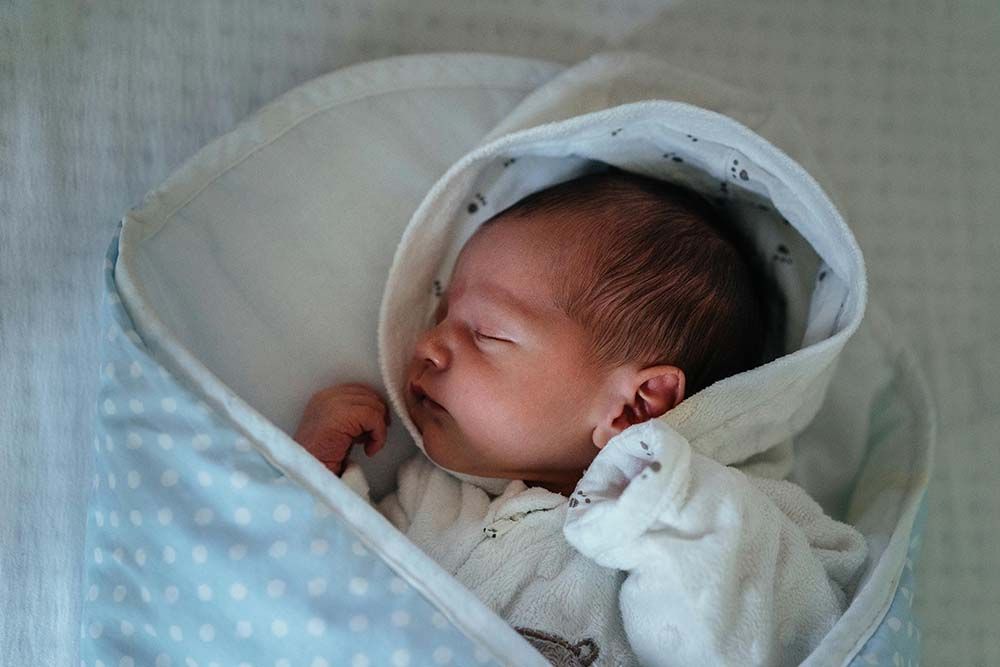

When your baby reaches 10 months old, they are in a stage of rapid development, usually demonstrating significant developmental milestones in movement, cognition , language and social interaction. For instance, they can crawl proficiently, stand, and even try to walk. Their fine motor skills are enhanced that can grab small objects with their hands and try to throw objects. They begin to make simple syllables or repeat sounds, and understand simple instructions. They spend more time on playing with toys or exploring the surroundings. They have more interactions with parents or caregivers, and so on.
However, their sleep comes to a dilemma, troubling their parents. Some may refuse to take naps, while some may won’t fall asleep unless being held. Some parents may question whether there is a 10 month sleep regression. Thus, this article will show you a comprehensive overview about this issue. If you need, just read on for more.
Seek for a Helpful Nursing Tool to Make it Easy
During this process, it is recommended to use Moonycare, which is a powerful App dedicated to helping track baby’s activities and then automatically generating a customized sleep schedule based on your baby’s condition. Thus, it frees you from remembering or writing down the timing manually, bringing great convenience to new parents.
IN THIS ARTICLE
Is There a 10-Month Sleep Regression?
Why Do 10-Month Sleep Regressions Happen?
10-Month Sleep Regression Signs
How Long does 10-Month Sleep Regression Last?
10-Month Sleep Regression or Separation Anxiety?
10-Month Sleep Regression or Teething?
How to Deal with 10-Month Sleep Regression?
Is it Acceptable to Sleep Train Your 10-month-old Baby During Sleep Regression Period?
Is There a 10 Month Sleep Regression?
Yes, 10 months old babies may indeed experience sleep regression, during which their previously good sleep patterns may be disrupted. This phenomenon is known as "10 month sleep regression" in the field of parenting. Although this term is widely used in parenting communities, there is no specific definition of the concept of "sleep regression" in scientific literature.
However, there are multiple studies and clinical observations that support the existence of this phenomenon and the science behind it. Babies may experience sleep problems when they are 10 months old due to their own development, the environment and many other factors. These problems are temporary and usually resolve on their own within a few weeks. But in the meantime, parents can also take some measures and comfort to help their babies better get through this stage.
Why Do 10-month-old Babies Have Sleep Regressions?
A 10-month-old baby may experience sleep problems due to the following reasons:
Growth and development: At this stage, infants are experiencing rapid physical and intellectual development, and they may become more curious and excited due to new motor skills, leading to increased activity at night and difficulty falling asleep peacefully.
Cognitive Development: Babies' memory is enhanced at this age, and they may remember daytime activities and stimuli, leading to active nighttime thinking and difficulty relaxing.
Circadian rhythm: The baby's biological clock is still being established, and there may be situations where they sleep too much during the day or have difficulty falling asleep at night.
Tooth growth: The process of growing teeth may cause discomfort in infants, leading to waking up at night.
Separation anxiety: Many infants begin to feel separation anxiety at this stage and may wake up at night because they want their parents' company.
Environmental changes: If there are changes in the family environment, such as moving or new members joining, it may affect the baby's sense of security and sleep.
Health issues: Colds, ear infections, and other health problems may also affect sleep.
Lifestyle habits: Irregular sleep patterns, improper diet, lack of exercise, etc. may lead to sleep problems.
What are the 10 Month Sleep Regression Signs?
When a 10-month-old baby experiences sleep regression, he/she may show a series of signs. Here are some common signs:
1. Frequently waking up at night: Babies may wake up frequently at night and have difficulty falling back asleep after each waking up. During this process, they may cry, become restless or difficult to calm.
2. Difficulty falling asleep: Babies may become particularly active before bedtime and find it difficult to calm down. Thus, they may need longer time to fall asleep and require more comfort and companionship.
3. Reduce daytime napping: Babies may have reduced nap time during the day, or even completely refuse to nap. Due to reduced daytime napping, babies may appear more tired and irritable during the day.
4. Emotional fluctuations: The baby's emotional changes may be more pronounced, and they may exhibit different reactions due to happiness, disappointment, or anger.
5. Seeking comfort: Babies may more often seek comfort and hugs from their parents when they feel uneasy.
6. Resistance to sleep: Babies may show resistance before bedtime, unwilling to lie in bed or fall asleep.
How Long Does 10 Month Sleep Regression Last?
In fact, it is usually a temporary phenomenon, but the specific duration varies depending on individual differences in the baby. Generally speaking, this phenomenon may last for several weeks to several months. In most cases, it may last for several weeks, typically between 2 and 6 weeks. But in some cases, the sleep regression may last longer, especially when the baby experiences multiple developmental milestones or faces other challenges.
Is it 10 Month Sleep Regression or Separation Anxiety?
Separation anxiety typically manifests as a strong attachment of the baby to their parents during both day and night, unwilling to leave their sight. Babies may show fear or anxiety towards strangers and be unwilling to interact with them. When parents leave their sight, babies may cry, become restless, or show obvious discomfort, and they especially need comfort and hugs from their parents when they wake up at night. In addition, babies may resist playing alone or staying alone in the room. These symptoms are not limited to nighttime, but are manifested throughout the day.
In contrast, the 10-month sleep regression is mainly concentrated at night and during nap time. The baby may wake up frequently at night and have difficulty falling asleep again, or become particularly active and difficult to calm down before bedtime. The nap time during the day may decrease, or even refuse to nap completely. The babies' mood may be more variable and obvious and they may show different reactions because of happiness, disappointment or anger.
Is it 10 Month Sleep Regression or Teething?
Teething problems usually manifest as noticeable discomfort during both the day and night. Babies may often bite their fingers, toys, or anything they can touch to relieve gum pain. During teething, babies may drool more and their cheeks may become red from teething. Babies may become fussy and cry because of gum pain, especially at night. In addition, babies' appetites may change, and they may refuse to eat solid foods but prefer to drink liquids. Sometimes, babies may also have a mild fever (a body temperature slightly higher than normal). These symptoms are not limited to the nighttime, but manifest around the clock. But for sleep regression, babies won’t show any obvious teething-related symptoms. As we have mentioned before, babies during this process may show frequent waking up, difficulty falling asleep, or excessive tiredness during the day instead.
How to Get My 10-month-old Baby to Sleep Through the Night?
How to deal with 10-month sleep regression? I have archived some effective methods to better cope with it, helping babies restore normal sleep patterns. I hope that these methods are helpful to you.
1. Establish a fixed daily routine
Regular schedule: Try to have your baby go to bed and wake up at the same time every day to help establish a stable biological clock.
Bedtime routine: Establish a fixed bedtime routine, such as bathing, reading stories, or singing lullabies, to help babies relax.
2. Provide comfort and a sense of security
Hugging and caressing: Give babies warm hugs and gentle touches to help them feel safe and comfortable.
Tap and Shake: Gently patting or shaking the baby's back can help them relax.
Pacifier: If the baby likes it, you can give them a pacifier.
3. Create a comfortable sleeping environment
Temperature: Keep the room temperature between 18-22 ° C (65-72 ° F) to ensure that the baby is neither too hot nor too cold.
Light: Keep the room light soft and avoid strong light stimulation. Night lights can be used, but the brightness should not be too high.
Noise: Keep the environment quiet and use a white noise machine or soft background music to help babies relax.
4. Observation and adjustment
Observe the baby's signals: Pay attention to the baby's drowsiness signals, such as rubbing the eyes, yawning, etc., and arrange for the baby to sleep instantly.
Adjust daytime activities: Ensure that babies have sufficient activity and outdoor time during the day, consume excess energy, and help them fall asleep better at night.
5. Maintain patience and support
Self-care: Ensure that you have enough rest and avoid excessive fatigue.
Emotional management: Taking care of a crying baby may make you feel stressed and anxious, so find a suitable way to relax, such as listening to music, meditation, etc.
6. Consult a doctor
Persistent issues: If your baby's sleep problems persist or are accompanied by other abnormal symptoms, it is recommended to consult a pediatrician in time to rule out potential health issues.
Detailed recording: Record the baby's sleep time, frequency, and other related symptoms for better diagnosis and assistance by doctors.
7. Temporary measures
Increase daytime activity: Ensure that babies have sufficient activity and outdoor time during the day, consume excess energy, and help them fall asleep better at night.
Reduce nap time: If babies take too long naps during the day, they can reduce nap time appropriately to help them fall asleep better at night.
Soothing techniques: Try different soothing techniques, such as using pacifiers, tapping, shaking, or playing white noise, to help babies relax and fall asleep.
An Optimal Sample for 10 Month Sleep Schedule
10-month-old babies usually require a lot of sleep to support their rapid growth and development. However, each baby's sleep needs are different, some babies may only need one short nap (about 1 hour), while others may require two naps. Parents can adjust their baby's schedule flexibly by observing their needs. When you notice your baby's signs of drowsiness, such as rubbing eyes, yawning, etc., you need to arrange for your baby to sleep promptly to avoid excessive fatigue. The following is an exemplary sleep schedule for a 10-month-old baby, for reference only:
- 7:00 AM: Morning rise and feeding
- 9:00 AM: Morning nap (1-1.5 hours)
- 11:00 AM: Feeding and Playtime
- 1:30 PM: Afternoon nap (1-1.5 hours)
- 3:00 PM: Wake, snack time and afternoon activities)
- 6:00 PM: Bedtime routine (bath, feeding and story time)
- 7:30 PM: Bedtime
Can You Sleep Train Your 10-month-old Baby During Sleep Regression Period?
It is feasible to conduct sleep training during sleep regression in a 10-month-old baby, but it requires caution and patience. The goal of sleep training is to help babies learn to fall asleep independently and self-soothe, but at this stage, babies may exhibit more sleep problems due to various reasons such as separation anxiety, new motor skills, etc. Here are some suggestions for sleep training during this period:
1. Evaluate the baby's condition
Observation reasons: Firstly, understand the specific causes of the baby's sleep problems, such as separation anxiety, new motor skills, physical discomfort, etc.
Health condition: Ensure that the baby is physically healthy and free from colds or other illnesses.
2. Choose appropriate sleep training methods
- Gradual retreat method: This method gradually reduces intervention on the baby and helps them learn to fall asleep independently. For example, gradually reducing the accompanying time from the beginning of falling asleep until the baby can fall asleep independently.
- Ferber method: This method is also known as the "asymptotic waiting method". When the baby wakes up at night, parents gradually increase the waiting time at predetermined intervals to teach the baby how to self-soothe.
- Timed check-ins: This method is similar to the Ferber method, but checks the baby at fixed time intervals and gradually extends the examination time interval.
- Cry It Out Method: This method requires parents to completely refrain from intervening when their baby wakes up at night, allowing the baby to learn self-soothing through crying.
3. Maintain consistency
Once the sleep training method is chosen, try to maintain consistency as much as possible. This can help babies adapt to new ways of falling asleep faster.
4. Consider the baby's emotions
During periods of sleep regression, babies may become more irritable or anxious. In this situation, maintain patience and ensure that they feel safe and cared for during the training process.
5. Pay attention to physiological needs
Ensure that the baby does not experience hunger, wet diapers, or discomfort before training to avoid affecting the effectiveness of the training.
6. Appropriate timing
If you find that your baby is very anxious or experiences significant emotional fluctuations during the training process, you may need to temporarily suspend the training and wait for the baby's emotions to stabilize before proceeding.
7. Monitoring progress
Pay attention to the baby's reaction. If you find that the method is not suitable, you can try other strategies. Sleep training is a gradual process, don't expect immediate results. Maintain patience and seek for step-by-step proceed instead.
In short, although training can be done during sleep regression, it is important to be flexible and adjust according to the baby's needs and emotions. If the training effect is not ideal, or if the baby's sleep problems persist for a long time, it is recommended to consult a pediatrician for professional advice.























